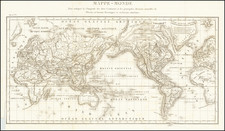Extremely rare separately issued double hemisphere map of the World, printed in London by Henry Overton, at the white Horse without Newgate in 1720.
This rare double-hemisphere map of the World is typical of English large format broadside maps of the early 20th Century, embellished with scientific details.
The map is embellished with a lengthy text on Newton's theory of tides and 2 smaller hemispheres of constellations at top. At the bottom is an illustration of the moon and other planets at middle and bottom, including a model of the Copernican System, the Ptolomaic Solar System, Tycho Brahe Model, Cassini Model, the moon's orbit around the earth, the face of the sun, and other scientific models.
Overton's map also includes an advertisement for a 5 foot long Overton Map of London.
This is apparently the first edition of this extremely rare map, which is listed by Ashley Baynton-Williams on Map Forurm issue #8 under The British Library Recent Acquisitions no on the Recent CD-Rom . . . (#17). We locate no other examples of the Overton edition of the map, although it would appear that a later example is held by Yale, listed as "Printed and sold by Geo. Foster . . . , 1737," with no reference to Overton, which is described as " mutilated along the folds, with some loss of text."
The Overton family was a prominent part of the printing, and mapmaking, industry in London in the seventeenth and eighteenth centuries. John Overton (1639/40-1713) was the son of a tailor who apprenticed to Stationer Thomas Gould. He was made free of the Stationers’ Company in 1663. Two years later, London was struck by the Great Plague of 1665-6. Peter Stent, a leading printseller, succumbed and Overton took over his shop. This burned in the Great Fire of 1666, but Overton had rebuilt by 1669, when he advertised his wares from the White Horse on Snow Hill. Overton specialized in prints, portraits, and especially maps and topographical views.
John was likely married three times and had seven children. His eldest, Thomas, emigrated to America. His second oldest, Henry, was executor of John’s will when the latter died in 1713. Henry (1675/6-1751) acquired his father’s stock in 1707 and ran the shop until his own death in 1751. He published many maps, most focusing on the British Isles. His shop and stock passed to his nephew, another Henry, son of John’s fourth son, James.
Henry the Elder’s brother, Philip (ca. 1681-1745), was also a printer and mapmaker. Philip served as his father’s apprentice and was made free of the Stationers’ in 1702. His father set him up in the trade in 1707 and by 1710 he was working from the sign of the Golden Buck in Fleet Street. Philip specialized in fine arts prints, including Hogarth’s Hudibras set (1726), but he also sold many maps. At his death in 1745 he left his shop to his widow, Mary. She ran the shop and then married James Sayer, whose brother, Robert, became Mary’s assistant. He took over the business in 1748 and became a famous purveyor of maps, charts, and views.
Back at the sign of the White Horse, Henry the Younger continued the family business, expanding their stock to include a large collection of landscape views. He often partnered with Robert Sayer. He continued in business until at least 1764, when he drops out of the historical record.









![[Early Fascimile of the Disputed Christopher Columbus Portolan Chart]](https://storage.googleapis.com/raremaps/img/small/66588.jpg)
![[ Lupus and Centaurus ] (Stars Heightened in Gold)](https://storage.googleapis.com/raremaps/img/small/83187.jpg)
![Earth Atlantic View [Waterman Projection]](https://storage.googleapis.com/raremaps/img/small/86011.jpg)
![Newsmap. Monday, June 29, 1942 [on verso:] Our Fighting Ships](https://storage.googleapis.com/raremaps/img/small/93346.jpg)

![[Map of the World on a Globular Projection Exhibiting Particularly the Nautical Researches of Capn. James Cook, F.R.S. with all the Recent Discoveries to the Present Time carefully Drawn by A. Arrowsmith . . . ]](https://storage.googleapis.com/raremaps/img/small/94140.jpg)